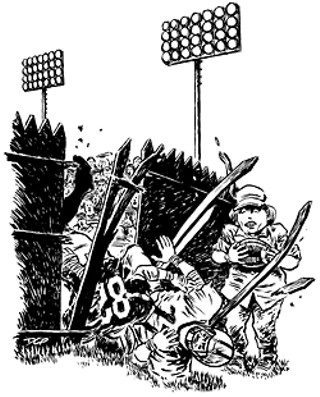Council Watch
There Goes the Neighborhood: Residents Doing Battle With Private School's Athletic Field
By Jenny Staff Johnson, Fri., Dec. 3, 1999

It's 2:30pm on a typical November afternoon in Travis Country, a Southwest Austin suburb of large houses, wide streets, and late-model family cars, and the sound of a group of girls playing kickball is wafting through the neighborhood. On this sunny fall day, the girls are having a big time: cheering each other on, celebrating the big plays -- you can hear it all walking your dog on the next block. You sigh and think, that's what neighborhoods like Travis Country were made for, right? Wrong, according to the Travis Country Community Service Association. It's not the odd kickball game they object to, per se, but the venue -- the newly installed athletic field (or, as Travis Country residents like to call it, the football stadium) of Regents School of Austin, a private, Christian institution that is the subdivision's newest neighbor in this community that lies just off the Southwest Parkway, next to the Barton Creek Greenbelt.
Allen Seale, president of the NA, says homeowners bought their property expecting the vacant, tree-filled lots behind them to be filled by more homes like theirs, but instead Regents built its gymnasium and primary athletics field -- between 40 and 70 feet from residents' back fences, depending on whom you ask -- which has resulted in noise complaints, as well as the potential for moderate pollution and other nuisances in the future as the school fulfills its plans to grow and expand. All of a sudden, Seale says, "their dream homes are in a very different position than they thought."
The school and the neighborhood have been squabbling about the field's location and uses for over six months, and the dispute has most recently centered on a list of demands from Travis Country that would address their traffic, noise, and lighting concerns, as well as limit the number and times of events held there. While Regents has remained a more reticent negotiator, the issue has caused a real stink in the neighborhood, where the locals are up in arms, posting anti-Regents fare on their Web site, and handing out flyers urging residents to seek redress from City Hall.
Also under dispute is what the extent of that redress might be: As it turns out, the edge of the affected residents' property is also the Austin city limit, where Austin's Travis Country turns into plain old Travis County. The city of Austin would have jurisdiction, though, if they annexed the school property, and that is exactly what the neighborhood is pushing for, in the hopes that the city could at least enforce noise and other public nuisance codes, and at most prevent expansion of the athletic facilities behind the houses and the addition of the dreaded stadium lighting. Though Regents is reportedly resisting annexation due to the possible effects on its plans for growth, the city had already planned to include Regents' land in an early 2000 annexation schedule, which also includes part of the Balcones Canyonlands Preserve System.
City Council Member Bill Spelman, who has been volunteer-mediating the dispute since this summer, says the city has "no authority other than moral authority" in the matter. "In reality, there's not that much we can do even if we annex them," he said. "It only works if the ball field is in violation of [the city's] compatibility standards; as it turns out, it's not. Still, if they were in the city limits, it would be a very bad idea for them to build the ball field, and we would still try like hell to stop 'em." Annexation would indeed not solve Travis Country's existing problems with the school, especially in light of the legislature's most recent foray into controlling such matters by way of Senate Bill 89. The bill was designed to give unincorporated areas more power in the annexation process, and one of its purposes is to prevent cities from annexing properties in order to control land use. (The bill also requires cities to make up three-year annexation plans, and the council will be considering a proposed plan at its Dec. 9 meeting.)
For the moment, Regents is laying low. A rumored counterproposal to Travis Country's list of demands has yet to materialize on paper, and at press time the school's representatives had not replied to the Chronicle's requests for comment. (Some parents of Regents students, who also happen to be residents of Travis Country, have stepped in to try to broker peace, however, handing out flyers responding to some of the neighborhood's most serious criticisms.)
Spelman is nonetheless optimistic that a compromise can be reached. Confirming the existence of the rumored counterproposal from Regents, he said it could include moving the lighted field across the street and retaining the existing field, which abuts the houses, as an unlighted practice field. "They have orally told us it's what they're going to do," he said. In exchange, the school would want the neighborhood to sign off on the rest of their site plan, agreeing not to resist its completion. "It's probably a good deal from the neighborhood's point of view," said Spelman. "It makes good sense for them to end the fighting now."

Seale says he would be open to such an agreement -- that is, if it achieved the goals already laid out in the neighborhood's recent list of demands -- but he feels that the school is acting in bad faith. Regents was reportedly red-tagged by inspectors earlier this month for building an extension to its gymnasium that's larger than what was indicated on the site plan, without some environmental permits required by the city (though it is outside the city limits, Regents receives city utility infrastructure, and therefore has to comply with some city regulations).
This was bound to happen sooner or later. Suburban and city folks are not as different as we may have led ourselves to believe. Most have ideas about how neighborhoods should be, and most will ultimately turn to the city for redress when conflicts over these ideas seem unresolvable. The dirty little secret of the folks who want to be free from city environmental and development relations is their enthusiastic support of the CCRs -- that's covenants, codes, and restrictions -- that micromanage the appearances of neighbors' property, and the types of permissible activity thereon. The idea is that they want to limit only such aesthetic choices or activities as would harm the quality of life or threaten property values in Travis Country, both of which residents -- naturally -- want to keep high. (By contrast, in some of the urban neighborhoods, residents are trying to keep the quality of life high and the property values low, but that's a cultural difference, and a story for another time.)
Of course, Travis Country is neither Circle C, nor one of those virulently anti-annexation northwest side neighborhoods. The subdivision was voluntarily annexed in 1985, along with much of Oak Hill, and has seemingly been a loyal subject of the city of Austin ever since. Their argument is that since they pay city taxes and fees, they should have the same protections as residents whose property does not lie along the city limits. But as Travis Country residents are finding out, living on the outskirts exposes residents to risks that inner-city neighborhoods, longtime foot soldiers in the zoning and neighborhood planning wars, have fought to insulate themselves against. As a result, the kind of political organization that made the Triangle Square development issue the most popular geometrical shape in Austin is creeping out toward the hinterlands.
It's a phenomenon this council has seen before. "For a neighborhood in an unincorporated area, it's pretty scary to get annexed," says Spelman. The only thing you can be certain of is that your taxes will go up. Once you get annexed, particularly if the services are good, then it's less of a jump to say, "How can we use this city stuff to advantage? How can we protect against unwanted land uses?'"
In their platonic, ideal form, neighborhood associations are about more than just protecting against unwanted land uses (though such vigilance, outside the scope of the city's capabilities, is one of the NAs' primary functions). As a neighborhood organization begins to find civic expression on all sides of town, and the city continues to increase funding for neighborhood planning initiatives, the potential for decentralized planning success -- and for blowing the opportunity altogether -- seem equally great.
This Week in Council:
Today's wave of civic activity will include, allegedly, the long-promised zoning agenda items for the Champion property at RM 2222 and Loop 360. The council's morning session will include a briefing and discussion on the Town Lake Corridor Study, the original intent of 1980s city government as it relates to Town Lake-front property, and the implications for the proposed Gotham condominium complex. The early meeting will also include a briefing on development in the Bull Creek watershed.
Evening public hearings will include one at 6pm on the city's proposed settlements with Gary Bradley, accompanied by a briefing on development and water quality in the Barton Springs Zone. There will also be a hearing on proposed amendments to the laws governing where cell phone towers can be located.
You can also expect to see more grilling of the city legal department, as the council will be asked to approve another $50,000 in late billing
from Akin Gump Strauss Hauer and Feld from the LCRA water deal process. ![]()
Got something to say on the subject? Send a letter to the editor.








